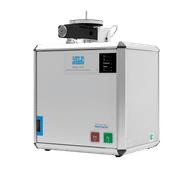Pitt researchers harness carbon nanomaterials for drug delivery systems, oxygen sensors
Researchers describe carbon nanocapsules for drug and energy storage in Advanced Materials, creation of highly sensitive oxygen sensors in Nature Chemistry
Two nanoscale devices recently reported by University of Pittsburgh researchers in two separate journals harness the potential of carbon nanomaterials to enhance technologies for drug or imaging agent delivery and energy storage systems, in one case, and, in the other, bolster the sensitivity of oxygen sensors essential in confined settings, from mines to spacecrafts.
In a report published online by Advanced Materials Aug. 12, a team led by chemistry professors Alexander Star and Stéphane Petoud in Pitt's School of Arts and Sciences describe the creation of nanosized capsules that are universally compatible with a range of substances, particularly related to medicine and energy. When applied to medicine, the tiny vessels can potentially carry a sizable "cargo" of anticancer drugs or medical-imaging agents, and could be steered via antibodies and biological molecules to specific locations within the human body. Energy applications include the storage of lithium and hydrogen in batteries and fuel cells. Pitt graduate chemistry student Brett Allen was the paper's lead author. The project also included chemistry graduate student Chad Shade and Adrienne Yingling, now a graduate of Pitt's PhD chemistry program.
In a separate paper appearing online in Nature Chemistry Aug. 16, another team headed by Star and Petoud revealed the development of a highly sensitive, fluorescent oxygen sensor that can detect minute amounts of the gas. Oxygen detectors are important safety devices in mines, aircraft, submarines, and other confined spaces, the researchers note. The sensor consists of carbon nanotubes coated with a luminescent compound incorporating europium, a reactive metal found in fluorescent bulbs, television/computer screens, and lasers, among other applications.
The researchers gauged oxygen levels by measuring the intensity of its glow when exposed to ultraviolent light and the tubes' change in electrical conductance. The tubes demonstrated sensitivity to oxygen concentrations as low as 5 percent (normal atmospheric concentration is around 20 percent) with the team calculating that it can indicate a level as low as 0.4 percent, and they were unaffected by other atmospheric gases, such as carbon dioxide and nitrogen. The second paper was authored by Shade and Pitt chemistry graduate students Douglas Kauffman and Hyounsoo Uh.
For both technologies, the Pitt teams worked with carbon nanomaterials to create enhanced versions of existing technologies. For instance, the oxygen sensor combines the small scale of carbon nanotubes - they are one-atom thick rolls of graphite 100,000 times smaller than a human hair - with the reactivity of the europium compound coating to produce a platform for low-cost, room-temperature detectors that are notably sensitive to oxygen but less complicated than existing sensors, the researchers write in Nature Chemistry.
Regarding the nanocapsules described in Advanced Materials, existing technologies are typically constructed of polymers that are permeable like a sponge and can result in leakage, Star explained. Additionally, each capsule must be tailored to its particular cargo, he said. The Pitt version employs graphite carbon shells bonded with glutaraldehyde - a common biological adhesive - creating a hollow storage space. More importantly, the graphite shells are chemically inactive and are thus compatible with any cargo substance without costly and time-consuming chemical preparation, Star said.
"For decades, researchers have been searching for an optimal vessel for storing and transporting a variety of cargo to specified locations," Star said. "Our devices have the potential to be universal delivery vehicles for a range of materials. Our next steps will focus on controlling how and when the nanocapsules open by using different stimuli such as pH, light, and chemical agents."
To illustrate the capsules' adaptability, the team loaded them with a luminescent imaging agent developed in Petoud's lab made of zinc sulfide semiconductor nanocrystals incorporating terbium, a metal chemically similar to europium. Once in the body, the substance would emit a unique light that allows easier detection and a better image, Petoud said. But the inorganic nanocrystals have to be prepared before being introduced to a biological environment such as the body and is difficult and time-consuming. The graphite nanocapsules, however, could hold and transport the solution with no preparation.
These products might interest you
See the theme worlds for related content
Topic world Antibodies
Antibodies are specialized molecules of our immune system that can specifically recognize and neutralize pathogens or foreign substances. Antibody research in biotech and pharma has recognized this natural defense potential and is working intensively to make it therapeutically useful. From monoclonal antibodies used against cancer or autoimmune diseases to antibody-drug conjugates that specifically transport drugs to disease cells - the possibilities are enormous

Topic world Antibodies
Antibodies are specialized molecules of our immune system that can specifically recognize and neutralize pathogens or foreign substances. Antibody research in biotech and pharma has recognized this natural defense potential and is working intensively to make it therapeutically useful. From monoclonal antibodies used against cancer or autoimmune diseases to antibody-drug conjugates that specifically transport drugs to disease cells - the possibilities are enormous

























































